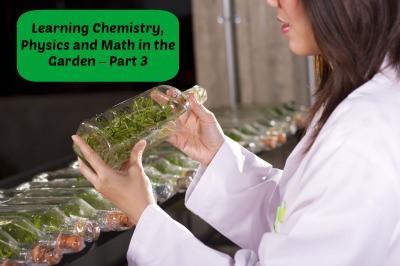 Agriculture is science. If you’re growing something – whether flowers in a pot on the windowsill or vast fields of vegetables – you’ve got a ready-built classroom.
Agriculture is science. If you’re growing something – whether flowers in a pot on the windowsill or vast fields of vegetables – you’ve got a ready-built classroom.
There are some obvious lessons: What does a seed require to sprout? How do plants “eat and drink” from the soil? Which animals are harmful/helpful to plants? Etc. But there are other things that can be learned in the garden as well. A good gardener has a grasp on chemistry, physics and math.
This post is the third in a series. If you’d like to read the first two to get some ideas on garden chemistry, earth science, and physics you can click here for part 1 and here for part 2.
Our family has loved homeschooling. Except when we have to do math. Math lessons invariably bring out the worst in our daughter. She is frustrated and angry, defiant and rude, sulky and whiney and generally miserable. Her misery radiates out into the rest of us.

This isn’t my child but that is certainly my child’s expression!
I’m not sure why her level of resistance is so high but I have begun to realize ways to teach her so she doesn’t realize she’s doing math. As it turns out, she’s actually pretty good at it when she’s not throwing a fit about being asked to do it!
Perimeter, area, multiplication, division and measuring
The garden is a perfect place to sneak in some math. Gardeners need to know exactly how much space they are working with and how many plants can comfortably fit in that space. Asking your child to help you figure out the basic needs of your garden will stimulate their little inner mathematician.
Consider using a square foot gardening method to make everything very simple and visual if your child is really struggling.
Great questions to let your student answer may include:
How many feet of fencing do we need to go around a garden that is 10 X 12?
If the perimeter is 44 feet and we need a fence pole every 4 feet, how many fence poles do we need?
What is the square footage of our garden?
If we can plant one seedling every 6 inches and our row is 6 feet long, how many seedlings can we plant here?
If we can put 16 carrot seeds in one square foot of garden and we want to grow at least 64 carrots, how many square feet of space should we set aside for carrots?
You get the idea. The questions are endless. These lessons can take place in the spring, with the warm earth beneath your feet, or in the most harsh part of winter with a piece of grid paper and a seed catalogue in front of you. The important thing to keep in mind is that you are NOT doing math! (*wink wink*) You are just planning a beautiful garden.
Before you leave, I’d love to introduce you to one of the blog’s wonderful sponsors!

Happy Moms, Healthy Homes is a wonderful business. They offer an incredibly wide range of eco-friendly, safe, natural products for your home and they provide a great business opportunity for those who are interested in working from home – without hosting big parties or constantly trying to sell stuff to your friends and family. Please take a minute to visit them. You won’t be disappointed!
Are you, too, seeking to save the earth, promote world peace and raise productive citizens without expending too much effort?
Why not follow Lazy Hippie Mama by email, Facebook, Google+, Twitter or Instagram to get all the updates?
If we work on our goals together, they may be a little easier to achieve!

